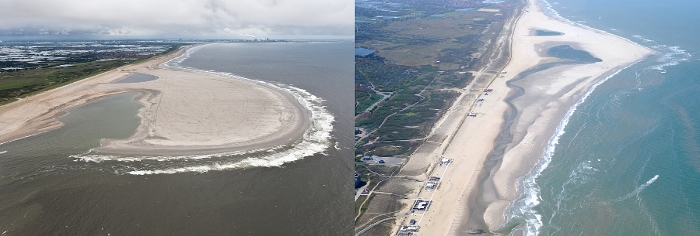Research project
The Sand Motor - Building with Nature to optimise coastal protection and other ecosystem services
How can mega sand nourishments, such as the Sand Motor, be designed and managed for optimal ecosystem services provision ?
- Duration
- 2013 - 2018
- Contact
- Alexander van Oudenhoven
- Funding
-
 STW
STW
-
 Sandmotor Partners
Sandmotor Partners
- Partners
Partners

The Sand Motor viewed from the north (May 2015). Photo: Rijkswaterstaat / Joop van Houdt
Short abstract
The Dutch coast is frequently strengthened through sand nourishments. The ‘Sand Motor’ is a mega nourishment designed to provide longer term coastal protection as well as additional ecosystem services.
Project description
Using natural processes for coastal protection
The Dutch coast is rapidly eroding, due to sea-level rise and extreme climate events. The ‘Sand Motor’ is a mega sand nourishment that relies on natural processes guided by winds, currents and tides to gradually distribute sand along the coast and dunes. Established in 2011, the Sand Motor is expected to be a more sustainable and nature-friendly intervention because it occurs less frequently and more gradually than a regular nourishment (20-30 years rather than ±5 years). Consequently, in addition to coastal protection, biodiversity and ecosystem services such as nature-based recreation and nursery for birds and juvenile fish should thrive at the Sand Motor.
Unique interdisciplinary research
Researchers of the
NatureCoast project are looking at many different aspects of the Sand Motor, such as from swimmer safety, marine & terrestrial ecology, dune formation, geo-morphology, aeolian transport and governance of mega nourishments. The NatureCoast project is yielding interesting new findings to science about sandy coastal ecosystems and sand nourishments. However, integrating the findings is crucially important to make them relevant and interesting to policy makers and other stakeholders.

The Sand Motor viewed from the north, right after construction (left, July 2011) and after almost four years of natural processes (right, May 2015). Photo: Rijkswaterstaat / Joop van Houdt
Using the ecosystem services concept to inform policy makers
Researchers at CML are, together with partners, responsible for integrating NatureCoast’s research into policy-relevant findings. Special attention is paid to the question how to optimise ecosystem services provision. Ecosystem services are ecosystem’s contributions to human wellbeing and the Sand Motor is expected to provide recreation opportunities, erosion prevention, habitat for characteristic animal and plant species etc. In the end, we hope to contribute to informed coastal decision making by recommending which biotic, abiotic and social factors contribute to which ecosystem service.
Publications
Stive M., de Schipper M., Luijendijk, A, Aarninkhof S, van Gelder-Maas C., van Thiel de Vries J., de Vries S., Henriquez M., Marx S., Ranasinghe R, 2013. A new alternative to saving our beaches from local sea-level rise: the Sand Engine. Journal of Coastal Research 29(5): 1001–1008.
Van Bodegom P.M., Price T, 2015. A traits-based approach to quantifying ecosystem services. Ch. 3 (40-64) in Ecosystem Services: From Concept to Practice, eds J. A. Bouma and P. J. H. van Beukering. Published by Cambridge University Press.
Relations with other projects
This project is part of the NatureCoast project ( www.naturecoast.nl). It integrates findings from six research projects that are also part of NatureCoast.
